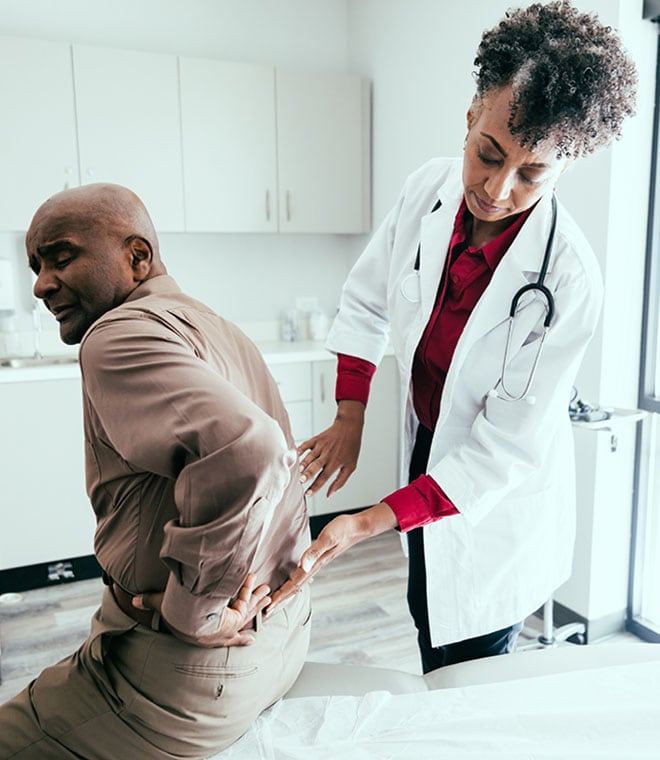Health
Headache locations and what they could mean
By Dr. Chelsea Grow, Board Certified Neurologist and Headache Specialist Dec 23, 2024 • 6 min
Whether you rarely get headaches or suffer them frequently, the location and type of pain you experience may provide clues about your headache type. However, different types of headaches can mimic one another or other health conditions, so location alone may not be enough for a diagnosis. Be sure to discuss any new or persistent headaches with your healthcare provider. They can conduct an examination and order tests, as needed, to diagnose your headaches.
Both sides of your head
When a headache occurs on both sides of your head, tension headaches may be to blame. Tension-type headaches are typically felt in the temporal region bilaterally (on both sides of the head). They usually evolve as the day progresses. They’re often described as a band-like tightness. The most common type of headaches, tension headaches occur when the muscles along the forehead and scalp contract due to stress, anxiety, an injury or holding your head still in a single position for an extended period. People often describe tension headaches as dull, non-throbbing pain.
Whole head
Pain affecting the entire head that feels like a tight, squeezing band could be a tension headache. However, in some cases, this type of headache may be a symptom related to COVID-19 or other viral or bacterial infections.
Band-like or whole-head headaches can be a symptom of an active infection, and in some people, they can continue for months after recovering from certain illnesses like COVID-19. These persistent headaches are also known as new daily persistent headaches (NDPHs). NDPHs may occur randomly or following a systemic trigger, such as an infection or stressful event. Researchers are still working to determine why NDPHs happen after COVID-19. Involvement of the trigeminal nerve, the main nerve involved in pain pathways for other types of headaches, including migraines, is also suspected to be linked with this type of headache.
One side of the head
A throbbing or pulsing headache felt on one side of the head is often a migraine. However, it’s possible for these symptoms to be caused by other types of headaches, including cluster headaches and hormonal headaches. While more research is necessary to fully understand what causes migraines, we do know that many people experience them in response to triggers, such as stress, hormonal changes, medications, foods, exercise and changes in weather. Involvement of the trigeminal vascular system in the brain is thought to cause the majority of migraines. Medications that are currently available to treat migraines typically have an effect on these areas of involvement in the brain. Along with pain, you may experience other symptoms with migraines, such as:
- Sensitivity to light, sounds or smells
- Nausea and vomiting
- Changes or disturbances in vision
- Pins and needles sensations in the arms or legs
- Muscle weakness on one side of the body or face
- Difficulty speaking
In women, fluctuation of estrogen levels can be a cause of headaches, including menstrual migraines and headaches associated with menopause.
People who suffer from migraines due to hormonal changes often sense the pain in their foreheads or on one side of their head. The discomfort may be dull or severe. You may also develop other symptoms with a hormonal headache, including:
- Sensitivity to light, sounds or smells
- Scalp tenderness
- Loss of appetite
- Dizziness
- Blurred vision
- Fatigue
- Nausea and vomiting
- Sweating or chills
Behind or around one eye
Headache pain located behind or around one eye that comes on suddenly may be a cluster headache or a migraine. The cause of cluster headaches isn’t fully understood, but the trigeminal nerve or a part of the brain called the hypothalamus may be involved.
People often describe cluster headaches as a stabbing or burning sensation, and you may develop these headaches around the same time daily. Other symptoms that can accompany a cluster headache include:
- Swelling around the eye
- Watering of the eye
- Eye redness
- Drooping eyelid
- Nasal congestion on the affected side
- Facial flushing
- Excessive perspiration
One localized spot
Pain isolated to a single spot in the front, back or side of your head may be due to dehydration. When your body doesn’t have enough fluids, tissues throughout your body shrink slightly. In your head, the shrinkage can put pressure on the brain, resulting in a headache that may feel dull or severe. Additional signs of dehydration include:
- Dark urine
- Less frequent urination
- Thirst
- Dry mouth
- Muscle cramps
- Loss of appetite
- Dizziness
- Confusion
- Fatigue
Entire face
Headaches positioned in the face, behind both eyes and across the cheeks may be due to congestion in your sinuses, the air-filled spaces behind your eyes, nose and cheeks. When the sinuses become inflamed due to an infection or allergies, mucus can accumulate inside, putting pressure on your face and triggering a headache. Most people describe sinus headaches as a constant, dull ache. Alternatively, trigeminal, neuralgia or other trigeminal nerve–related headaches often present with facial pain and may mimic a sinus or dental issue.
Although headaches are a common health complaint, they can be a sign of a more serious health condition, which may even be life-threatening. It’s best to seek immediate medical care if you have severe or new headache symptoms that you haven’t experienced before.
Updated December 2024.
Sources:
- https://health.clevelandclinic.org/why-you-get-headaches-and-where
- https://health.clevelandclinic.org/long-covid-headaches
- https://my.clevelandclinic.org/health/diseases/5005-migraine-headaches
- https://my.clevelandclinic.org/health/diseases/5003-cluster-headaches
- https://my.clevelandclinic.org/health/diseases/21517-dehydration-headache
- https://my.clevelandclinic.org/health/diseases/8260-menstrual-migraines-hormone-headaches
- https://my.clevelandclinic.org/health/diseases/9641-sinus-headaches
- https://www.mayoclinic.org/diseases-conditions/chronic-daily-headaches/diagnosis-treatment/drc-20370897
- https://www.mayoclinic.org/diseases-conditions/migraine-headache/symptoms-causes/syc-20360201
- https://medlineplus.gov/ency/article/000797.htm
- https://medlineplus.gov/ency/article/000786.htm
- https://www.merckmanuals.com/professional/neurologic-disorders/headache/tension-type-headache
- https://www.uptodate.com/contents/new-daily-persistent-headache
- https://www.ninds.nih.gov/health-information/disorders/headache
- https://www.health.harvard.edu/pain/headache-when-to-worry-what-to-do
- https://www.merckmanuals.com/professional/neurologic-disorders/headache/migraine
- https://www.mayoclinic.org/diseases-conditions/chronic-daily-headaches/in-depth/headaches/art-20046729
- https://familydoctor.org/condition/migraine/
- https://medlineplus.gov/ency/patientinstructions/000424.htm



